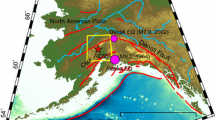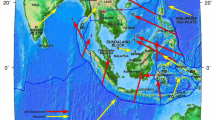Abstract
Global positioning system (GPS) technologies have been increasingly employed to monitor landslide movements. This paper demonstrates the use of GPS in the study of a creeping landslide in Ponce, Puerto Rico. The landslide is primarily composed of chalk colluvium that extends to depths of about 30 m at the head zone and 2 to 3 m at the toe zone. The slip surface lies at the base of the chalk colluvium, which slides southeast over a weathered brown mudstone unit. GPS monitoring of the landslide began in March 2008. Both campaign rapid static and continuous static GPS surveying methods were applied. Precision at the level of 0.5 mm horizontally and 1.3 mm vertically was achieved through 24-h continuous GPS monitoring. Rainfall data from a local weather station was also integrated into the study. Rainfall heavily influenced the movements of the landslide. A heavy rainfall in September 2008, which dumped 50 cm rain on the landslide area over a 4-day period, temporarily accelerated the sliding and generated rapid movement of 1 m horizontally and 0.5 m vertically. The slide slowed markedly after this significant movement. A prolonged moderate rainfall in November 2009 also temporarily accelerated the sliding. The landslide remains active. The creeping appears likely to continue in the future with short bursts of rainfall-induced rapid movements. Potential landslide causes are investigated, and two measures to minimize future risk are proposed at the end of the article.















Similar content being viewed by others
References
Anderson SA, Sitar N (1995) Analysis of rainfall-induced debris flow. J Geotech Eng ASCE 121(7):544–552
Avila LA (2008) Tropical cyclone report—Hurricane Kyle. National Hurricane Center. :http://www.nhc.noaa.gov/pdf/TCR-AL112008_Kyle.pdf. Accessed 29 Nov 2009
Banuchi R (2008) Heavy rains drench Puerto Rico. USA Today (September 23, 2008). http://www.usatoday.com/weather/storms/2008-09-22-puerto-rico-flooding-rains_N.htm. Accessed 29 Nov 2009
Baum RL, Chleborad AF, Schuster RL (1998) Landslides triggered by the December 1996 and January 1997 storms in the Puget Sound area, Washington. US Geological Survey Open-File Report 98-239
Brand EW (1981) Some thoughts on rainfall induced slope failures. Proceedings of 10th International Conference on Soil Mechanics and Foundation Engineering, pp 373–376
Bruckl E, Brunner FK, Kraus K (2006) Kinematics of a deep-seated landslide derived from photogrammetric, GPS and geophysical data. Eng Geol 88:149–159
Coe JA, Ellis WL, Godt JW, Savage WZ, Savage JE, Michael JA, Kibler JD, Powers PS, Lidke DJ, Debray S (2003) Seasonal movement of the Slumgullion landslide determined from global positioning system surveys and field instrumentation, July 1998–March 2002. Eng Geol 68:67–101
Dickinson PR, Thornton N (2004) Cracking and building movement, published by RICS Business Services Limited, ISBN 1-84219-156-x. The Royal Institute of Chartered Surveyors, UK
Dogan U (2007) Accuracy analysis of relative positions of permanent GPS stations in the Marmara region, Turkey. Surv Rev 39(304):156–165
Eckl MC, Snay RA, Soler T, Cline MW, Mader GL (2001) Accuracy of GPS derived relative positions as a function of interstation distance and observing-session duration. Journal of Geodesy 75:633–640
Frei E, Beutler G (1990) Rapid static positioning based on the fast ambiguity resolution approach (FARA): theory and first results. Manuscripts Geodaetia 15:325–356
Gili JA, Corominas J, Rius J (2000) Using global positioning system techniques in landslide monitoring. Eng Geol 55:167–192
Guzzetti F, Cardinali M, Reichenbach P, Clipolla F, Sebastiani C, Galli M, Salvati P (2004) Landslides triggered by the 23 November 2000 rainfall event in the Imperia Province, Western Liguria, Italy. Eng Geol 73:229–245
Guzzetti F, Peruccacci S, Rossi M, Stark CP (2008) The rainfall intensity–duration control of shallow landslides and debris flows: an update. Landslides 5:3–17
Herring TA, King RW, McCluskey SM (2009) Introduction to GAMIT/GLOBK, release 10.35. MIT, Cambridge
Iverson RM (2000) Landslide triggering by rain infiltration. Water Resour Res 36(7):1897–1910
Jibson RW (1986) Evaluation of landslide hazards resulting from the 5–8 October 1985 storm in Puerto Rico. U.S. Geological Survey Open-File Report 86-26
Jibson RW (1989) Debris flows in southern Puerto Rico. Geol Soc Am, special paper 236, pp 29–55
Joyce J (2008) Geology of the Cerca del Cielo landslide site. Geotechnical report on landslide investigation, analyses and remedial measures at Cerca Del Cielo Community Tallaboa Ward, Ponce, Puerto Rico. Suelos Inc., May 2008 (Engineering report, not formally published)
Krushensky RD, Monroe WH (1978) Geological map of the Penuelas and Punta Cuchara quadrangles, Puerto Rico: U.S. Geological Survey miscellaneous investigations map I-1042, scale 1:20,000
Lan H, Zhou C, Lee CF, Wang S, Wu F (2003) Rainfall-induced landslide stability analysis in response to transient pore pressure. Science in China Ser E Technological Sciences 46:52–68
Larsen MC (2008) Rainfall-triggered landslides, anthropogenic hazards, and mitigation strategies. Advances in Geosciences 14:147–153
Larsen MC, Simon A (1993) Rainfall-threshold conditions for landslides in a humid-tropical system, Puerto Rico. Geografiska Annaler 75A(1–2):13–23
Larsen MC, Torres-Sanchez AJ (1996) Geographic relations of landslide distribution and assessment of landslide hazards in the Blanco, Cibuco, and Coamo river basins, Puerto Rico. U.S. Geological Survey Water-Resources Investigations Report 95-4029, 56 p
Larsen MC, Torres-Sanchez AJ (1998) The frequency and distribution of recent landslides in three Montane tropical regions of Puerto Rico. Geomorphol 24(4):309–331
Larsen MC, Webb RMT (2009) Potential effects of runoff, fluvial sediment, and nutrient discharges on the Coral Reefs of Puerto Rico. J of Coast Res 25:189–208
Larsen MC, Santiago M, Jibson R, Questell E (2004) Map showing susceptibility to rainfall-triggered landslides in the municipality of Ponce, Puerto Rico. U.S. Geological Survey Scientific Investigations Map I-2818, 1 p
Malet JP, Maquaire O, Calais E (2002) The use of global positioning system techniques for the continuous monitoring of landslides—application to the Super-Sauze earthflow (Alpesde Haute-Province, France). Geomorphol 43:33–54
Matsuura S, Asano S, Okamoto T (2008) Relationship between rain and/or meltwater, pore-water pressure and displacement of a reactivated landslide. Engineering Geology 101:49–59
Monroe WH (1964) Large retrogressive landslides in north-central Puerto Rico. U.S. Geological Survey Professional Paper 501, Chapter B, B123–B125
Monroe WH (1979) Map showing landslides and areas of susceptibility to landsliding in Puerto Rico. U.S. Geological Survey Miscellaneous Investigations Series Map I-1148, 1 sheet, scale 1:240,000
Mora P, Baldi P, Casula G, Fabris M, Ghirotti M, Mazzini E, Pesci A (2003) Global positioning systems and digital photogrammetry for the monitoring of mass movements: application to the Ca di Malta landslide (northern Apennines, Italy). Eng Geol 68:103–121
Peyret M, Djamour Y, Rizza M, Ritz JF, Hurtrez JE, Goudarzi MA, Nankali H, Chery J, Le Dortz K, Uri F (2008) Monitoring of the large slow Kahrod landslide in Alboz mountain range (Iran) by GPS and SAR interferometry. Eng Geol 100:131–141
Polemio M, Sdao F (1999) The role of rainfall in the landslide hazard: the case of the Avigliano urban area (Southern Apennines, Italy). Eng Geol 53:297–309
Psimoulis P, Ghilardi M, Fouache E, Stiros S (2007) Subsidence and evolution of the Thessaloniki plain, Greece, based on historical leveling and GPS data. Eng Geol 90:55–70
Sato HP, Abe K, Ootaki O (2003) GPS-measured land subsidence in Ojiya City, Niigata Prefecture, Japan. Eng Geol 67:379–390
Silva-Tulla F (1986) The October 1985 landslide at Barrio Mameyes, Ponce. National Academy, Washington, D.C
Soler T, Michalak P, Weston ND, Snay RA, Foote RH (2006) Accuracy of OPUS solutions for 1- to 4-h observing sessions. GPS Solut 10(1):45–55. doi:10.1007/s10291-005-0007-3
Squarzoni C, Delacourt C, Allemand P (2005) Differential single-frequency GPS monitoring of the La Valette landslide (French Alps). Eng Geol 79:215–229
Suelos Inc. (2008) Geotechnical report on landslide investigation, analyses and remedial measures at Cerca Del Cielo Community Tallaboa Ward, Ponce, Puerto Rico (engineering report)
Tagliavini F, Mantovani M, Marcato G, Pasuto A, Silvano S (2007) Validation of landslide hazard assessment by means of GPS monitoring technique—a case study in the Dolomites (Eastern Alps, Italy). Nat Hazards and Earth System Sciences 7:185–193
Terzaghi k (1950) Mechanism of landslides. In: Paige S (ed) Application of geology to engineering practice. Geological Society of America, New York, pp 83–123
The Climate Source Inc. (2002) PRISM 1963–1995 mean annual precipitation, Puerto Rico. http://www.climatesource.com/pr/fact_sheets/prppt_xl.jpg. Accessed 05 Jan 2010
Wang G, Sassa K (2003) Pore-pressure generation and movement of rain-fall-induced landslides: effects of grain size and fine-particle content. Eng Geol 69:109–125
Wang G, Phillips D, Joyce J, Rivera FO (2011) The integration of TLS and continuous GPS to study landslide deformation: a case study in Puerto Rico. J of Geodetic Sci 1(1):25–34. doi:10.2478/v10156-010-0004-5
Acknowledgments
I acknowledge Dr. James Joyce (University of Puerto Rico at Mayaguez) for many thoughtful discussions about the geology aspects of this landslide and Mr. Cesar E. Pujos (Department of Transportation, Puerto Rico) for supplying local maps and geotechnical documents. I appreciate Dr. Robert W. King (MIT) for answering many questions related to the GAMIT software and his comments on an early version of this manuscript. I would also like to acknowledge Mr. Carlos Ponce for his support in our research and education activities at the landslide site. Many undergraduate students in the Departments of Geology and Civil Engineering at the University of Puerto Rico-Mayaguez have been involved in the field surveying. I appreciate their hard work. This study was funded by NSF projects (EAR-0722540, EAR-0842314) and a NASA Puerto Rico Space Grant. The two continuous GPS units were provided by UNAVCO through its Equipment Loan Program. I appreciate Jim Normandeau, Frederick Blume, and Charles Meertens (UNAVCO) for their technical support.
Author information
Authors and Affiliations
Corresponding author
Rights and permissions
About this article
Cite this article
Wang, GQ. Kinematics of the Cerca del Cielo, Puerto Rico landslide derived from GPS observations. Landslides 9, 117–130 (2012). https://doi.org/10.1007/s10346-011-0277-5
Received:
Accepted:
Published:
Issue Date:
DOI: https://doi.org/10.1007/s10346-011-0277-5




